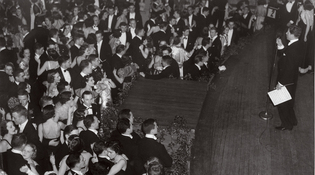 loading
loading
Old YaleMay I have this dance?Judith Ann Schiff is chief research archivist at the Yale University Library.  Manuscripts & ArchivesAt the 1937 Prom, 2,500 guests filled Woolsey Hall, the famous crooner Rudy Vallée ’27 (at right) performed, and the last stragglers didn't leave until 4:00 a.m. View full imageFor a third of Yale’s history, from the 1870s to the 1970s, the Prom was the social high point of the winter season. Officially it was the Junior Promenade, but just as “The Game” said it all, so did “The Prom.” The occasion, held in January or February, involved much more than the formal dance that was its feature event. It was a glorious round—often lasting three days—of parties, dinners, concerts, theater, and athletic matches. A New Haven newspaper described the 1893 Prom as a “Vortex of Pleasure.” An invitation to the Prom was a testament to a young woman’s social success and justified any expense and display of wealth. The 1893 newspaper report on the Prom singled out one attendee’s dress as “pink satin en traine over a Venetian red velvet petticoat slashed, displaying pink satin pleating.” An 1899 Yale history by Lewis Sheldon Welch ’89 and Walter Camp ’80 shows how the presence of the “Prom girl” must have boosted the local economy: upon her departure, “the heart of Yale is sad. And all the University is in thrall—to her, and—to others. To landlords and landladies; to tailors; to them also that deal in fine linen and in kidskins and dogskins; to violet-mongers; to the monopolist who works the endless chain of hacks, and to many others.” Prom customs over the years reveal much about social mores. For a time, freshmen were admitted to the dance only to sit in the balcony as observers. In 1902 this led to a riot, as the freshmen threw humorous handbills down to the young women, with messages such as, “Look up Dame. Cast your orbs aloft and behold a man again.” The 1899 history cites a discussion over whether “a student who invites a young lady to the Prom is supposed to pay the traveling and hotel expenses of this young lady and her chaperon.” In 1933 the Yale Daily News offered a test for selecting the ideal Prom girl: “Good looks and style, pep and the ability to make snappy comebacks, intelligent conversation, and good dancing.” That was also the era of satirist Dorothy Parker’s famous one-liner, quoted by Alexander Woolcott in 1934: “And there was that wholesale libel on a Yale prom. If all the girls attending it were laid end to end, Mrs. Parker said, she wouldn’t be at all surprised.” The 1937 Prom was said to be the greatest in recent years: 2,500 guests filled Woolsey Hall, with the seats removed for dancing. The News called it a new age. The opening of the residential colleges, the end of prohibition, and the waning of the Great Depression raised Yale spirits. It was no longer the era of “coon-skin coats, Stutz Bearcat roadsters, and gin.” The Prom started at 11:00 p.m. on Friday, February 26, following a Glee Club concert. The Grand March of the participating couples took place at 11:15. Rudy Vallée ’27 and his Connecticut Yankees performed from the Woolsey Hall stage, while Pete Leno and his 15-piece rumba and swing band played “hot numbers” for the “wolves and strollers” and overflow crowd in the rotunda and Memorial Hall. Just before the midnight supper in Commons, the junior who had been voted “most popular” was ceremoniously awarded a large wooden spoon. (The custom had been adapted in 1847 from a similar tradition at the University of Cambridge.) Dancing resumed until 3:00 a.m. There were ten dances for which the men had to reserve places beforehand on the women’s dance cards, but cutting in was permitted during the two encores following each card dance. It was 4:00 a.m. when the last stragglers left the hall. Even the onset of war in 1941 did not cancel the Prom. “Mrs. [Emily] Post in an exclusive statement to the News said: ‘It will, I think, be in best taste to announce that owing to the war the arrangements for the Prom will be simplified as much as possible, and that tails will be out of order.’” In the same 1942 issue of the News, the following ad appeared: “WALDORF FOR YOUR PROM TO-HIRE. / New FULL DRESS Suits / ‘TAILS’ / Opera Hats—Accessories . . . / RESERVE YOUR ‘TAILS’ NOW!” Student activism and the coeducation of the college in 1969 brought an end to the Junior Prom in 1974. It was revived occasionally; abandoned for good in 1987; and new college dances have replaced it. But we can look back with some nostalgia at the tradition that meant so much to the male bastion that was Yale College. A century ago, Welch and Camp’s history captured the tender afterglow of the Prom: “Yale is not yet herself. In twenty-four hours more her sons will shade their classic brows with those bandless and bacterial slouch hats and be ready for the serious business of life. Today is the day of sad and sleepy goodbyes and sweet reflections.”
The comment period has expired.
|
|